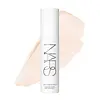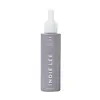What's inside
What's inside
 Key Ingredients
Key Ingredients

 Benefits
Benefits

 Concerns
Concerns

 Ingredients Side-by-side
Ingredients Side-by-side

Water
Skin ConditioningPropanediol
SolventGlycerin
HumectantSqualane
EmollientIsodecyl Neopentanoate
EmollientC9-12 Alkane
SolventPolyurethane-35
Mica
Cosmetic ColorantTrehalose
HumectantChondrus Crispus Extract
Skin ConditioningCamellia Japonica Flower Extract
EmollientTheobroma Cacao Seed Extract
AntioxidantMoringa Oleifera Seed Extract
Skin ConditioningSodium Hyaluronate
HumectantGluconolactone
Skin ConditioningMethylpropanediol
SolventCaprylyl Glycol
EmollientPhenylpropanol
MaskingHydrogenated Lecithin
EmulsifyingCoco-Caprylate/Caprate
EmollientSodium Carrageenan
Emulsion StabilisingSea Salt
AbrasivePhytosteryl/Octyldodecyl Lauroyl Glutamate
Skin ConditioningTocopherol
AntioxidantMangifera Indica Seed Butter
Skin ConditioningOrbignya Oleifera Seed Oil
EmollientPhospholipids
Skin ConditioningTocopheryl Acetate
AntioxidantHydroxyethyl Acrylate/Sodium Acryloyldimethyl Taurate Copolymer
Emulsion StabilisingPolysorbate 60
EmulsifyingSorbitan Isostearate
EmulsifyingAmmonium Acryloyldimethyltaurate/Vp Copolymer
Sodium PCA
HumectantSodium Acrylates Crosspolymer-2
AbsorbentHydrolyzed Hyaluronic Acid
HumectantXanthan Gum
EmulsifyingLecithin
EmollientSclerotium Gum
Emulsion StabilisingPullulan
Silica
AbrasiveSynthetic Fluorphlogopite
Trisodium EDTA
Sodium Citrate
BufferingCitric Acid
BufferingButylene Glycol
HumectantPentylene Glycol
Skin ConditioningDisodium Phosphate
BufferingPhenoxyethanol
PreservativeSodium Benzoate
MaskingBenzyl Alcohol
PerfumingCI 77491
Cosmetic ColorantCI 14700
Cosmetic ColorantCI 77891
Cosmetic ColorantCI 19140
Cosmetic ColorantWater, Propanediol, Glycerin, Squalane, Isodecyl Neopentanoate, C9-12 Alkane, Polyurethane-35, Mica, Trehalose, Chondrus Crispus Extract, Camellia Japonica Flower Extract, Theobroma Cacao Seed Extract, Moringa Oleifera Seed Extract, Sodium Hyaluronate, Gluconolactone, Methylpropanediol, Caprylyl Glycol, Phenylpropanol, Hydrogenated Lecithin, Coco-Caprylate/Caprate, Sodium Carrageenan, Sea Salt, Phytosteryl/Octyldodecyl Lauroyl Glutamate, Tocopherol, Mangifera Indica Seed Butter, Orbignya Oleifera Seed Oil, Phospholipids, Tocopheryl Acetate, Hydroxyethyl Acrylate/Sodium Acryloyldimethyl Taurate Copolymer, Polysorbate 60, Sorbitan Isostearate, Ammonium Acryloyldimethyltaurate/Vp Copolymer, Sodium PCA, Sodium Acrylates Crosspolymer-2, Hydrolyzed Hyaluronic Acid, Xanthan Gum, Lecithin, Sclerotium Gum, Pullulan, Silica, Synthetic Fluorphlogopite, Trisodium EDTA, Sodium Citrate, Citric Acid, Butylene Glycol, Pentylene Glycol, Disodium Phosphate, Phenoxyethanol, Sodium Benzoate, Benzyl Alcohol, CI 77491, CI 14700, CI 77891, CI 19140
Zinc Oxide 12%
Cosmetic ColorantWater
Skin ConditioningC12-15 Alkyl Benzoate
AntimicrobialJojoba Esters
EmollientCaprylic/Capric Triglyceride
MaskingPolyglyceryl-4 Diisostearate/Polyhydroxystearate/Sebacate
EmulsifyingPropanediol
SolventTridecyl Salicylate
Skin ConditioningNiacinamide
SmoothingNylon-12
Methylpropanediol
SolventSilica
AbrasiveCoco-Caprylate
EmollientBisabolol
MaskingAllantoin
Skin ConditioningOryza Sativa Bran Extract
Skin ConditioningHelianthus Annuus Extract
EmollientTocopherol
AntioxidantRosmarinus Officinalis Leaf Extract
AntimicrobialPolyglyceryl-2 Dipolyhydroxystearate
Skin ConditioningSodium Chloride
MaskingCaprylyl Glycol
EmollientLecithin
EmollientStearalkonium Hectorite
Gel FormingPolyglyceryl-3 Diisostearate
EmulsifyingPolyglyceryl-3 Polyricinoleate
EmulsifyingPhenylpropanol
MaskingTetrasodium Glutamate Diacetate
Hydrogenated Lecithin
EmulsifyingSodium Hydroxide
BufferingIron Oxides
CI 77491
Cosmetic ColorantCI 77499
Cosmetic ColorantCI 77492
Cosmetic ColorantZinc Oxide 12%, Water, C12-15 Alkyl Benzoate, Jojoba Esters, Caprylic/Capric Triglyceride, Polyglyceryl-4 Diisostearate/Polyhydroxystearate/Sebacate, Propanediol, Tridecyl Salicylate, Niacinamide, Nylon-12, Methylpropanediol, Silica, Coco-Caprylate, Bisabolol, Allantoin, Oryza Sativa Bran Extract, Helianthus Annuus Extract, Tocopherol, Rosmarinus Officinalis Leaf Extract, Polyglyceryl-2 Dipolyhydroxystearate, Sodium Chloride, Caprylyl Glycol, Lecithin, Stearalkonium Hectorite, Polyglyceryl-3 Diisostearate, Polyglyceryl-3 Polyricinoleate, Phenylpropanol, Tetrasodium Glutamate Diacetate, Hydrogenated Lecithin, Sodium Hydroxide, Iron Oxides, CI 77491, CI 77499, CI 77492
Ingredients Explained
These ingredients are found in both products.
Ingredients higher up in an ingredient list are typically present in a larger amount.
Caprylyl Glycol is a humectant and emollient, meaning it attracts and preserves moisture.
It is a common ingredient in many products, especially those designed to hydrate skin. The primary benefits are retaining moisture, skin softening, and promoting a healthy skin barrier.
Though Caprylyl Glycol is an alcohol derived from fatty acids, it is not the kind that can dry out skin.
This ingredient is also used as a preservative to extend the life of products. It has slight antimicrobial properties.
Learn more about Caprylyl GlycolCi 77491 is also hydrated iron III oxide. It's sole purpose is to give a red/pink hue to products.
Iron III oxides are classified as inorganic chemicals for coloring.
Synthetically created Ci 77491 is considered safer than those naturally found. This is because the synthetically created version may contain less impurities. Iron oxides are generally non-toxic and non-allergenic.
Learn more about CI 77491Hydrogenated Lecithin is created from the hydrogenation of lecithin (a group of phospholipids). Hydrogenation is a chemical reaction between hydrogen and another element.
This ingredient is an emollient and emulsifier. As an emollient, it helps soften skin by trapping moisture within. As an emulsifier, it prevents oil and water ingredients from separating.
Lecithin is a term for a group of substances found in the cell membranes of plants, animals, and humans. They are made up of mixture of phospholipids.
This ingredient has emollient and emulsifying properties.
As an emollient, lecithen helps soften the skin and creates a barrier to keep moisture in.
As an emulsifier, it also helps prevent water and oil ingredients from separating. Lecithin can also help ingredients be better absorbed by the skin.
This is because the phospholipids in lecithin produce liposomes. Liposomes help other ingredients get through the skin barrier.
Depending on the source of this ingredient, lecithin may not be fungal acne safe. This is because some sources of lecithin come from soybean oil, which may feed the malassezia yeast that feeds fungal acne.
We recommend reaching out to the brand you are purchasing from to inquire about the source of their lecithin.
Some other names for this ingredient include soy lecithin and deoiled soy lecithin.
Learn more about LecithinMethylpropanediol is a synthetic solvent and humectant.
As a solvent, it helps dissolve other ingredients, helping to evenly distribute ingredients throughout the product. This ingredient has also been shown to have antimicrobial properties which makes it a preservative booster.
Methylpropanediol is able to add a bit of moisture to the skin. It also helps other ingredients be better absorbed into the skin, such as salicylic acid.
Learn more about MethylpropanediolPhenylpropanol is a fragrance.
Propanediol is an all-star ingredient. It softens, hydrates, and smooths the skin.
It’s often used to:
Propanediol is not likely to cause sensitivity and considered safe to use. It is derived from corn or petroleum with a clear color and no scent.
Learn more about PropanediolSilica, also known as silicon dioxide, is a naturally occurring mineral. It is used as a fine, spherical, and porous powder in cosmetics.
Though it has exfoliant properties, the function of silica varies depending on the product.
The unique structure of silica enhances the spreadability and adds smoothness, making it a great texture enhancer.
It is also used as an active carrier, emulsifier, and mattifier due to its ability to absorb excess oil.
In some products, tiny microneedles called spicules are made from silica or hydrolyzed sponge. When you rub them in, they lightly polish away dead skin layers and enhance the penetration of active ingredients.
Learn more about SilicaTocopherol (also known as Vitamin E) is a common antioxidant used to help protect the skin from free-radicals and strengthen the skin barrier. It's also fat soluble - this means our skin is great at absorbing it.
Vitamin E also helps keep your natural skin lipids healthy. Your lipid skin barrier naturally consists of lipids, ceramides, and fatty acids. Vitamin E offers extra protection for your skin’s lipid barrier, keeping your skin healthy and nourished.
Another benefit is a bit of UV protection. Vitamin E helps reduce the damage caused by UVB rays. (It should not replace your sunscreen). Combining it with Vitamin C can decrease sunburned cells and hyperpigmentation after UV exposure.
You might have noticed Vitamin E + C often paired together. This is because it is great at stabilizing Vitamin C. Using the two together helps increase the effectiveness of both ingredients.
There are often claims that Vitamin E can reduce/prevent scarring, but these claims haven't been confirmed by scientific research.
Learn more about TocopherolWater. It's the most common cosmetic ingredient of all. You'll usually see it at the top of ingredient lists, meaning that it makes up the largest part of the product.
So why is it so popular? Water most often acts as a solvent - this means that it helps dissolve other ingredients into the formulation.
You'll also recognize water as that liquid we all need to stay alive. If you see this, drink a glass of water. Stay hydrated!
Learn more about Water